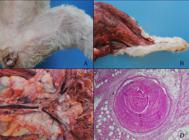ABSTRACT:
This study aimed to present epidemiological, clinical and anatomopathological data of five dogs with ischemic neuromyopathy secondary to aortic thrombosis or thromboembolism. The dogs were females, with eleven years of age or more, that had paraplegia (80%) or hind limb monoplegia (20%). Forty percent of the cases (n=2) had lameness previously the motor disfunction. The main clinical findings include absence of unilateral or bilateral femoral pulse, cool hind limbs extremities, muscle pain above the knee joint and absence of nociception (deep pain) on the hind limbs digits. Four dogs were euthanized due to the poor prognosis, and the last one died within 24 hours of hospital admission. The necropsy findings were cardiac lesions in three dogs, neoplastic disease in one, and unknown cause on the other. The thrombi were located on the abdominal aorta, extending to the iliac arteries. Even with low incidence, the ischemic neuromyopathy should be included in the differential diagnosis of dogs with lameness, paraparesis, or unilateral or bilateral paraplegia, when neurological signs are compatible with lower motor neuron lesion (L4-S3) and acute or chronic progression. The digital and/or vascular doppler evaluation of the femoral pulse must be used and can assist on the disease diagnosis, avoiding treatments for other illnesses.
INDEX TERMS:
Aorta; thromboembolism; canine; thrombus; ischemic neuromyopathy

 Thumbnail
Thumbnail
